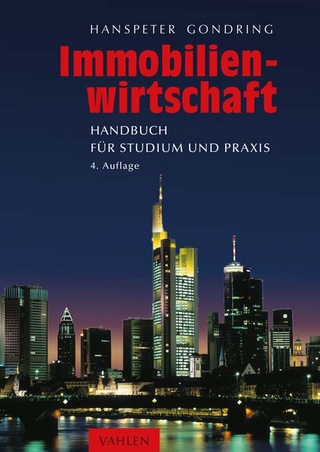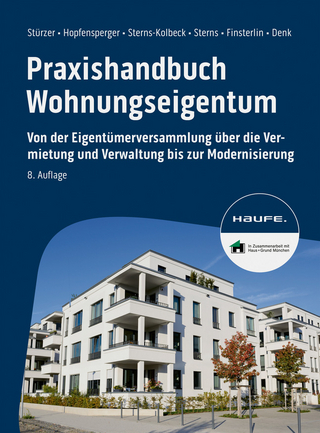
Residential Property Appraisal
Routledge (Verlag)
978-1-032-15991-1 (ISBN)
Residential Property Appraisal, Volumes 1 and 2, are handbooks not only for students studying residential surveying but also for those involved in the appraisal of residential property.
Volume 1 has been updated and covers the valuation process as it relates to residential properties, particularly when valuation is undertaken for secured lending purposes. It addresses the basic skills required, the risks posed in a valuation, the key drivers of value, emerging issues that impact valuation and the key legal and RICS regulatory considerations that a valuer needs to understand.
Volume 2 of the series goes on to consider the practical aspects of the survey and inspection of residential properties in more detail. Not only does this include updated sections on the most common defects (for example, building movement, moisture problems, wood rot and wood-boring insects), it also covers emerging challenges, including assessing personal safety hazards, modern construction technologies and materials and invasive plants. The volume also takes account of the Home Survey Standard recently published by the RICS and the changes resulting from climate change, the energy crisis and concerns about fire safety.
Building services in domestic residential properties is another area of rapid change, especially with the development of low-carbon and renewable technologies. To ensure that this aspect is covered in sufficient detail, the content is to be included in Volume 3: Assessing Building Services.
An essential book for students studying to enter the residential survey and valuation profession and for existing practitioners who wish to improve their knowledge of current practices.
Phil Parnham is a Chartered Building Surveyor and was a director at BlueBox partners and has over 40 years’ experience in the property sector. He spent his first ten years working in local government and for housing associations where he developed an interest in residential defects. He took up an academic post at Sheffield City Polytechnic (latterly Sheffield Hallam University) where he helped develop their building surveying course at all levels. He left academia and joined up with Chris Rispin in 2010 to form BlueBox partners where he jointly organised and delivered a range of training courses and other services for those working in the residential property sector. In September 2021, BlueBox partners was acquired by Sava and Phil set up his own training and development consultancy creatively named Phil Parnham Ltd. During this time Phil has also written a number of books, journal articles and conference papers. The most notable examples include: the RICS Survey Writer Sample Phrases for the RICS Condition and HomeBuyer Reports, The Surveyor’s Guide to RICS Home Surveys, the Domestic Energy Assessor’s Handbook, and Assessing Building Services (all for the RICS) and Residential Property Appraisal. In addition, he was the technical author for RICS’s information paper on Japanese knotweed (first edition) and the RICS professional statement on the Home Survey Standard. Phil is aiming to retire in the near future but like many of those in the residential sector he is unlikely to achieve this goal. Although he has given up rushing around the conference and seminar circuit, he can often be found in his office in Sharrow, Sheffield engaging in what he calls ‘deep thinking’. Larry Russen is a chartered building surveyor with over 40 years’ practical experience in residential, industrial and commercial property. He is a chartered building engineer and party wall surveyor and established Russen & Turner Chartered Surveyors in King’s Lynn in 1981. Over the last 20+ years, he has enjoyed training thousands of surveyors, engineers and energy assessors with RICS, Sava and BlueBox partners. His mantra for any surveyor, aspiring or practicing, is ‘it’s all about your attitude and attention to detail’.
1. Introduction 2. Setting up the service 3. Carrying out the service 4. Diagnosing building defects 5. Building movement 6. Moisture problems in buildings 7. Wood rot, wood-boring insects, pests and troublesome plants 8. Roofs and associated parts 9. External joinery, other parts and decorations 10. Internal matters 11. External and environmental issues 12. Non-standard forms of construction 13. Assessing safety hazards for occupants 14. Writing the report 15. Service completion, documentation storage and retention.
| Erscheinungsdatum | 24.11.2022 |
|---|---|
| Zusatzinfo | 5 Tables, black and white; 114 Line drawings, black and white; 87 Halftones, black and white; 201 Illustrations, black and white |
| Verlagsort | London |
| Sprache | englisch |
| Maße | 174 x 246 mm |
| Gewicht | 1120 g |
| Themenwelt | Naturwissenschaften ► Biologie ► Ökologie / Naturschutz |
| Technik ► Bauwesen | |
| Wirtschaft ► Betriebswirtschaft / Management ► Rechnungswesen / Bilanzen | |
| Betriebswirtschaft / Management ► Spezielle Betriebswirtschaftslehre ► Immobilienwirtschaft | |
| ISBN-10 | 1-032-15991-X / 103215991X |
| ISBN-13 | 978-1-032-15991-1 / 9781032159911 |
| Zustand | Neuware |
| Haben Sie eine Frage zum Produkt? |
aus dem Bereich


